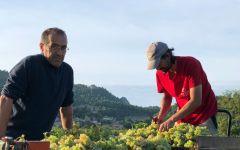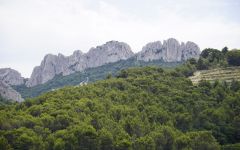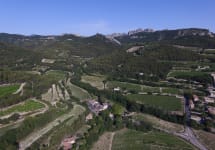Chateau de Saint Cosme Gigondas 2018
-
Robert
Parker -
Jeb
Dunnuck - Decanter
-
Wine
Spectator -
Wine &
Spirits



Product Details
Your Rating
Somm Note
Winemaker Notes
In years like this, Saint Cosme often reveals its "Burgundian" style, reminiscent of delicate Pinot and its aromas of red berries, forest floor and violets. Salinity acts as a flavor enhancer and freshness underscores the harmony of the whole, with all its charm and depth. Blend: 70% Grenache, 14% Syrah, 15% Mourvedre, 1% Cinsault
Professional Ratings
-
Robert Parker's Wine Advocate
Saint Cosme's 2018 Gigondas is a blend of 70% Grenache, 15% Mourvèdre, 14% Syrah and 1% Cinsault, aged in a combination of new and used oak, with 30% of the volume matured in concrete. Full-bodied and generous, it's round and supple, with no hard edges to hamper the easy flow of asphalt, red raspberries and black cherries across the palate. Boasting ample but not excessive concentration, it's a lovely, seductive example of Gigondas to enjoy over the next decade or so.
-
Jeb Dunnuck
Moving to the wines from bottle, the base Gigondas from this estate is a perennial winner and readers can safely buy bottles of this in just about every vintage. Giving up a Provençal bouquet of red and black currants, peppery herbs, leather, and loamy soil, the 2018 is medium to full-bodied, has a forward, sexy style, no hard edges, and a great finish. It’s terrific today yet still has enough tannins to evolve for 10-15 years if you’re so inclined.
-
Decanter
Immediately very expressive, with a touch of elderberry among the bright damson, lifted by subtle sandalwood spice. Only medium-bodied on the palate, bright, brisk and lively, with precise acidity and salinity through the palate. Beautifully fresh and drinkable with a medium-length finish. Drinking Window 2019 - 2030
-
Wine Spectator
A restrained style, with hints of garrigue and sage out front and a core of lightly dried red cherry and dark plum fruit picking up light brick dust and incense accents. Long, mineral-edged finish leaves a nice echo.
-
Wine & Spirits
As with all of Louis Barruol’s wines, this comes from organically farmed vines and was fermented as whole bunches with ambient yeasts; 30 percent aged in cement tanks while the rest went into a mix of used and new casks. It feels supple and relaxed, with a black-pepper spice that reinforces the wine’s brisk, fresh acidity. Its foresty herbal notes and inviting demeanor suggest a match with lamb grilled over rosemary.
Other Vintages
2021- Vinous
-
Wine
Spectator -
James
Suckling -
Jeb
Dunnuck
-
Wine
Spectator -
Jeb
Dunnuck -
Wine
Enthusiast
-
Robert
Parker -
Wine
Spectator -
Wine
Enthusiast - Decanter
-
Jeb
Dunnuck
-
James
Suckling -
Jeb
Dunnuck -
Wine
Spectator -
Robert
Parker -
Wine
Enthusiast - Decanter
-
Wine
Spectator -
Robert
Parker -
James
Suckling -
Jeb
Dunnuck
-
Wine
Spectator -
James
Suckling -
Robert
Parker
-
Wine
Spectator -
Robert
Parker
-
Wine
Spectator -
Robert
Parker
-
Robert
Parker
-
Wine
Spectator -
Robert
Parker
-
Wine
Spectator -
Robert
Parker
-
Wine
Spectator -
Robert
Parker
-
Wine
Spectator
-
Wine
Spectator -
Robert
Parker
-
Robert
Parker -
Wine
Spectator
-
Robert
Parker
-
Robert
Parker
-
Robert
Parker
-
Robert
Parker
-
Robert
Parker







Chateau de Saint Cosme is the leading estate of Gigondas and produces the appellation’s benchmark wines. Wine has been produced on the site of Saint Cosme since Roman times, evident by the ancient Gallo-Roman vats carved into the limestone below the chateau. The property has been in the hands of Louis Barruol’s family since 1570. Henri and Claude Barruol took over in 1957 and gradually moved Saint Cosme away from the bulk wine business. Henri was one of the first in the region to work organically beginning in the 1970s. Louis Barruol took over from his father in 1992, making a dramatic shift to quality, adding a négociant arm to the business in 1997, and converting to biodynamics in 2010.

With bold fruit flavors and accents of sweet spice, Grenache, Syrah and Mourvèdre form the base of the classic Rhône Red Blend, while Carignan, Cinsault and Counoise often come in to play. Though they originated from France’s southern Rhône Valley, with some creative interpretation, Rhône blends have also become popular in other countries. Somm Secret—Putting their own local spin on the Rhône Red Blend, those from Priorat often include Merlot and Cabernet Sauvignon. In California, it is not uncommon to see Petite Sirah make an appearance.

The Southern Rhône region of Gigondas extends northwest from the notably jagged wall of mountains called the Dentelles di Montmirail, whose highest point climbs to about 2,600 feet. The region and its wines have much in common with the neighboring Chateauneuf-du-Pape except that the vineyards of Gigondas exist at higher elevation and its soils, comprised mainly of crumbled limestone from the Dentelles, often produce a more dense and robust Grenache-based red wine.
The region has a history of fine winemaking, extending back to Roman times. But by the 20th century, Gigondas was merely lumped into the less distinct zone of Côtes du Rhône Villages. However, it was first among these satellite villages to earn its own appellation, which occurred in 1971.
Gigondas reds must be between 50 to 100% Grenache with Syrah and Mourvèdre comprising the bulk of the remainder of the blend. They tend express rustic flavors and aromas of wild blackberry, raspberry, fig, plum, as well as juniper, dried herbs, anise, smoke and river rock. The best are bold but balanced, and finish with impressively sexy and velvety tannins.
The Gigondas appellation also produces rosé but no white wines.
